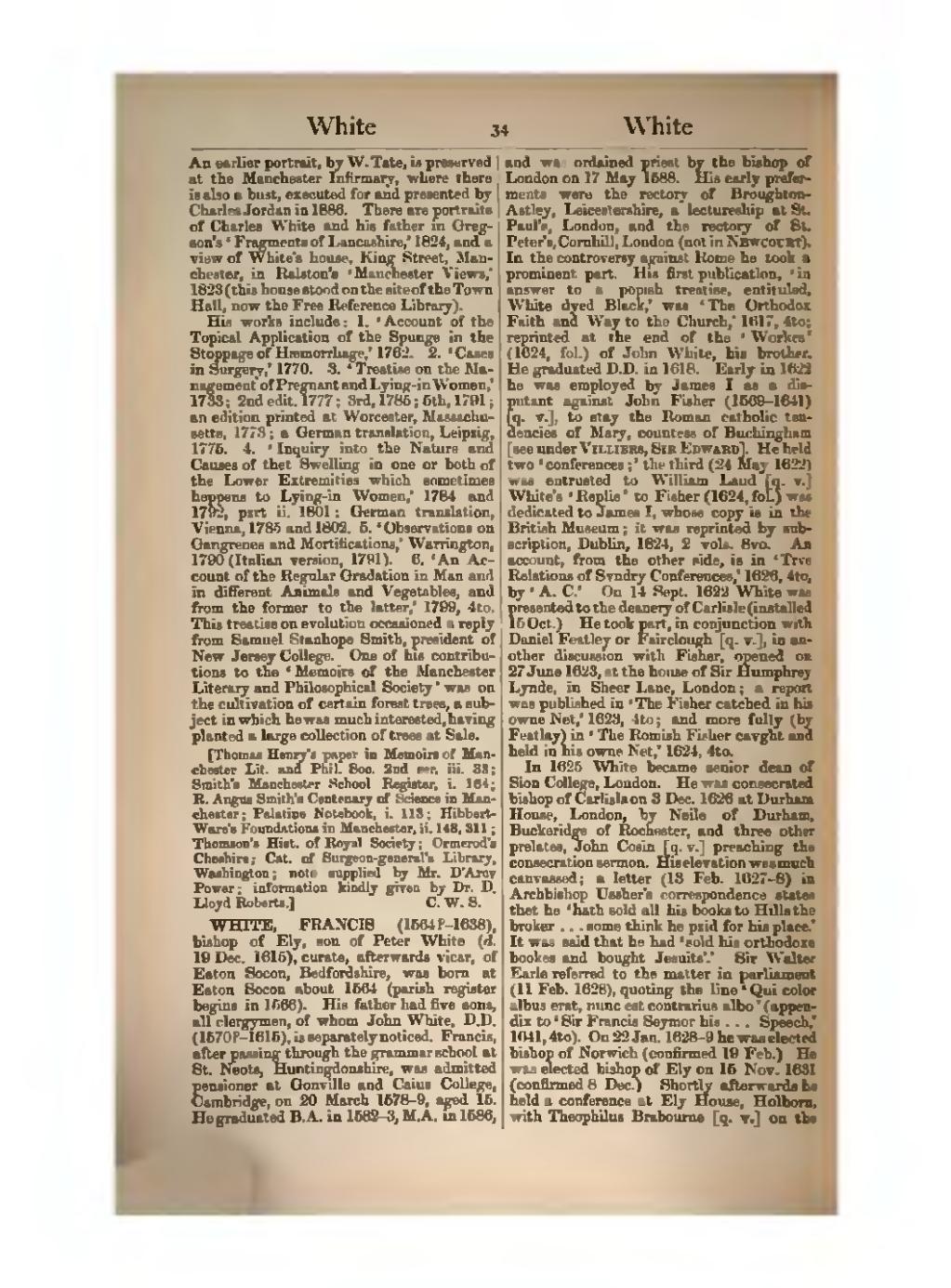An earlier portrait, by W. Tate, is preserved at the Manchester Infirmary, where there is also a bust, executed for and presented by Charles Jordan in 1886. There are portraits of Charles White and his father in Gregson's ‘Fragments of Lancashire,’ 1824, and a view of White's house, King Street, Manchester, in Ralston's ‘Manchester Views,’ 1823 (this house stood on the site of the Town Hall, now the Free Reference Library).
His works include: 1. ‘Account of the Topical Application of the Spunge in the Stoppage of Hæmorrhage,’ 1762. 2. ‘Cases in Surgery,’ 1770. 3. ‘Treatise on the Management of Pregnant and Lying-in Women,’ 1773; 2nd edit. 1777; 3rd, 1784; 5th, 1791; an edition printed at Worcester, Massachusetts, 1793; a German translation, Leipzig, 1775. 4. ‘Inquiry into the Nature and Causes of that Swelling in one or both of the Lower Extremities which sometimes happens to Lying-in Women,’ 1784 and 1792, part ii. 1801; German translation, Vienna, 1785 and 1802. 5. ‘Observations on Gangrenes and Mortifications,’ Warrington, 1790 (Italian version, 1791). 6. ‘An Account of the Regular Gradation in Man and in different Animals and Vegetables, and from the former to the latter,’ 1799, 4to. This treatise on evolution occasioned a reply from Samuel Stanhope Smith, president of New Jersey College. One of his contributions to the ‘Memoirs of the Manchester Literary and Philosophical Society’ was on the cultivation of certain forest trees, a subject in which he was much interested, having planted a large collection of trees at Sale.
[Thomas Henry's paper in Memoirs of Manchester Lit. and Phil. Soc. 2nd ser. iii. 33; Smith's Manchester School Register, i. 164; R. Angus Smith's Centenary of Science in Manchester; Palatine Notebook, i. 113; Hibbert-Ware's Foundations in Manchester, ii. 148, 311; Thomson's Hist. of Royal Society; Ormerod's Cheshire; Cat. of Surgeon-general's Library, Washington; note supplied by Mr. D'Arcy Power; information kindly given by Dr. D. Lloyd Roberts.]
WHITE, FRANCIS (1564?–1638), bishop of Ely, son of Peter White (d. 19 Dec. 1615), curate, afterwards vicar, of Eaton Socon, Bedfordshire, was born at Eaton Socon about 1564 (parish register begins in 1566). His father had five sons, all clergymen, of whom John White, D.D. (1570?–1615), is separately noticed. Francis, after passing through the grammar school at St. Neots, Huntingdonshire, was admitted pensioner at Gonville and Caius College, Cambridge, on 20 March 1578–9, aged 15. He graduated B.A. in 1582–3, M.A. in 1586, and was ordained priest by the bishop of London on 17 May 1588. His early preferments were the rectory of Broughton-Astley, Leicestershire, a lectureship at St. Paul's, London, and the rectory of St. Peter's, Cornhill, London (not in Newcourt). In the controversy against Rome he took a prominent part. His first publication, ‘in answer to a popish treatise, entituled, White dyed Black,’ was ‘The Orthodox Faith and Way to the Church,’ 1617, 4to; reprinted at the end of the ‘Workes’ (1624, fol.) of John White, his brother. He graduated D.D. in 1618. Early in 1622 he was employed by James I as a disputant against John Fisher (1569–1641) [q. v.], to stay the Roman catholic tendencies of Mary, countess of Buckingham [see under Villiers, Sir Edward]. He held two ‘conferences;’ the third (24 May 1622) was entrusted to William Laud [q. v.] White's ‘Replie’ to Fisher (1624, fol.) was dedicated to James I, whose copy is in the British Museum; it was reprinted by subscription, Dublin, 1824, 2 vols. 8vo. An account, from the other side, is in ‘Trve Relations of Svndry Conferences,’ 1626, 4to, by ‘A. C.’ On 14 Sept. 1622 White was presented to the deanery of Carlisle (installed 15 Oct.). He took part, in conjunction with Daniel Featley or Fairclough [q. v.], in another discussion with Fisher, opened on 27 June 1623, at the house of Sir Humphrey Lynde, in Sheer Lane, London; a report was published in ‘The Fisher catched in his owne Net,’ 1623, 4to; and more fully (by Featley) in ‘The Romish Fisher cavght and held in his owne Net,’ 1624, 4to.
In 1625 White became senior dean of Sion College, London. He was consecrated bishop of Carlisle on 3 Dec. 1626 at Durham House, London, by Neile of Durham, Buckeridge of Rochester, and three other prelates, John Cosin [q. v.] preaching the consecration sermon. His elevation was much canvassed; a letter (13 Feb. 1627–8) in Archbishop Ussher's correspondence states that he ‘hath sold all his books to Hills the broker … some think he paid for his place.’ It was said that he had ‘sold his orthodoxe bookes and bought Jesuits'.’ Sir Walter Earle referred to the matter in parliament (11 Feb. 1628), quoting the line ‘Qui color albus erat, nunc est contrarius albo’ (appendix to ‘Sir Francis Seymor his … Speech,’ 1641, 4to). On 22 Jan. 1628–9 he was elected bishop of Norwich (confirmed 19 Feb.). He was elected bishop of Ely on 15 Nov. 1631 (confirmed 8 Dec.) Shortly afterwards he held a conference at Ely House, Holborn, with Theophilus Brabourne [q. v.] on the
